 Leading Blog | Posts by Month |
 Leading Blog | Posts by Month |
07.31.21

LeadershipNow 140: July 2021 Compilation
See more on
Posted by Michael McKinney at 06:31 AM
07.30.21

Raising Kids to Thrive in an Online World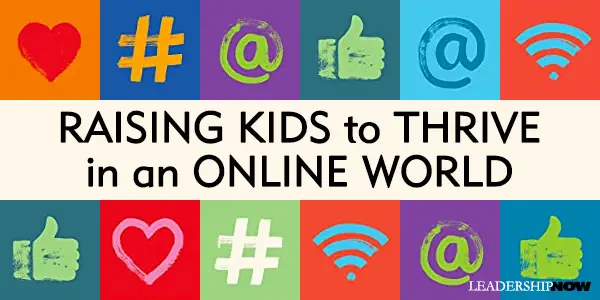
RAISING KIDS in the physical world is hard enough to get right, but now there is the added dimension of the digital world. While we spend a good deal of time preparing our kids for success in the physical world, Richard Culatta says, “we have put surprisingly little effort into making sure our kids are prepared to be safe and healthy” in the digital world. In Digital for Good: Raising Kids to Thrive in an Online World, Culatta writes that the “events that take place in the virtual world are not ancillary to their lives but are some of the most important elements in them.” For all the good the virtual world has to offer, it is also filled with wicked problems. Most of them stem from one fundamental flaw: we never took the time to establish the ground rules for meaningful participation. We have spent the last two decades excitedly finding ways to migrate all kinds of experiences to the digital world, but we haven’t stopped to ask how we will preserve our civil society as it also migrates there. For all the good the virtual world has to offer, it is also filled with wicked problems. Most of them stem from one fundamental flaw: we never took the time to establish the ground rules for meaningful participation. We have spent the last two decades excitedly finding ways to migrate all kinds of experiences to the digital world, but we haven’t stopped to ask how we will preserve our civil society as it also migrates there. With no expectation for acceptable behavior and near-complete anonymity, we have created an environment that is optimized for self-destruction. When we do try to teach our kids, our conversation about online safety is too limited, focusing on not sharing personal information, talking to digital strangers, or posting things they might regret later. We need to broaden the conversation “to articulate a broader, more meaningful vision for the use of tech to enrich our children’s lives.” And when we do have those conversations, we need to take a positive approach—not just a list of don’ts, but positive behaviors our kids can practice doing while in the digital world. Culatta, who is the CEO of the International Society for Technology in Education and the former Director of the Office of Educational Technology for the U.S. Department of Education, has developed a framework that we should use to guide our approach to teaching digital citizenship:
Using screen time as the primary factor for moderating tech takes away our children’s ability to learn to self-regulate. We want our kids to learn to move on to new activities when it is appropriate to do so, not just because a timer runs out. Change the conversation. Instead of saying you’re addicted to your phone, provide an example of a physical-world activity that isn’t getting enough priority. Culatta provides suggestions to reframe other common conversations like, “You’ve been playing that game too long,” Stop sitting around on the computer all day,” and You need to interact with real people.” And hold app reviews with your child.
Help them learn to identify useful information from junk. Emphasize asking better questions, selecting the best sources, and evaluating relevant answers. Helpful questions to ask are, “Can you validate the claims with another source?” “How old is the information?” and “Does the content us hyperbolic, alarmist, or emotional language?” Wikipedia never claimed to be a reliable source, but instead, it is a starting point to gather basic information for deeper learning journeys.
Mostly, algorithms “don’t just show us more of our same beliefs, but more extreme versions of those beliefs….It seems as if you are never ‘hard core’ enough for YouTube’s recommendation algorithm.” If we don’t prepare young people to understand how to value and respect multiple, opposing viewpoints, they may forfeit one of their greatest learning opportunities and, worse, treat people who hold opposing viewpoints disrespectfully. Of course, we have to model this in our behavior, even as outspoken individual, organizational, and governmental voices don’t.
Indexing projects “allow people worldwide to digitize important historical artifacts to make them searchable and discoverable online. There is an app that connects sighted volunteers to visually impaired people through their mobile devices. “If a blind person needs help with a particular task, say, reading the expiration date on a carton of milk or reading a phone number, they can connect with a sighted person through the app to have it read to them.” Additionally, they can help strengthen family relationships by connecting, capturing family experiences, and preserving family stories.
Culatta focuses on a positive approach that can be implemented now, even if you feel like the situation has already gotten out of hand. Young people will learn from our example. If we are to teach these positive behaviors to our children, it is assumed that we know them and practice them ourselves. All of this seems strangely helpful for adults to consider as well?!? Technology has no conscience—that’s our job. The same technologies that can solve our toughest human problems can also divide and destroy us with remarkable efficiency. 
Posted by Michael McKinney at 08:36 AM
07.29.21

Leading Thoughts for July 29, 2021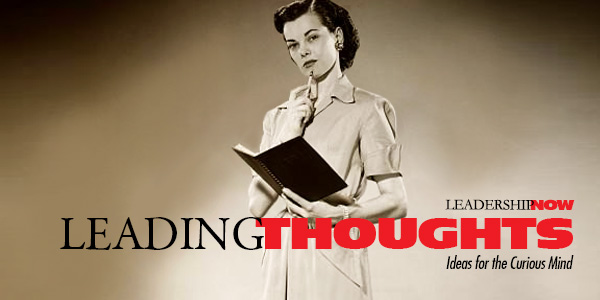
IDEAS shared have the power to expand perspectives, change thinking, and move lives. Here are two ideas for the curious mind to engage with: Motivational speaker Les Brown on having an indomitable spirit: “There are negatively charged people who allow events to control their lives, and there are positively charged people who remain in control of their lives no matter what life throws at them. You want to be positively charged. “ Source: Live Your Dreams Reid Hoffman and Ben Casocha say opportunities are the result of doing something—by being motion: “Opportunities do not float like clouds. They are firmly attached to individuals. If you’re looking for an opportunity, you’re really looking for people. If you’re evaluating an opportunity, you’re really evaluating people. If you’re trying to marshal resources to go after an opportunity, you’re really trying to enlist the support and involvement of other people.” Source: The Start-up of You: Adapt to the Future, Invest in Yourself, and Transform Your Career Look for these ideas every Thursday on the Leading Blog. Find more ideas on the LeadingThoughts index.
Posted by Michael McKinney at 07:18 AM
07.26.21

Become a Brand Renegade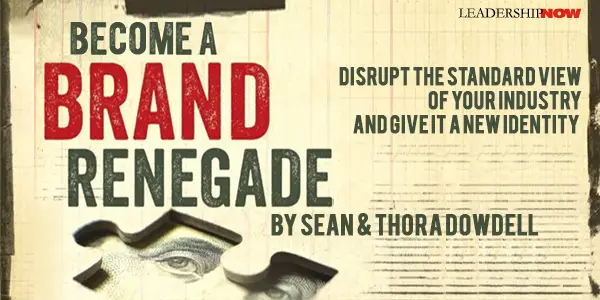
OVER THE PAST FEW DECADES, we’ve seen several examples of “brand renegades.” These are the industry disruptors who have changed how business is conducted in distinctly powerful ways. Think how Uber transformed the transportation industry, how Airbnb took over the lodging industry — not to mention how Tesla is upending both the automobile and energy industries. A brand renegade makes huge changes that everyone else turns their heads to notice. The successful brand renegade has staying power and causes others to ask, “What are they doing, and how can we do it, too?” Our business, Club Tattoo, has disrupted the tattoo and piercing industry. As we built our business, we realized that we had a unique opportunity to reset common perceptions of the industry and take our brand to a national level. To do that, we had to lean into a “brand renegade” mindset and apply it to our daily operations. With each decision, we asked ourselves what’s the best way to do something and could we make it even better. “How it’s always been done” was never our standard. Today, Club Tattoo is a multimillion-dollar business empire with its Club Tattoo luxury studios. Our success lies in our willingness to take bold action, to take calculated risks, and to conduct business in a completely different way. We didn’t care that “it’s never been done before.” Instead, we focused on our brand and how to flip the script on growing a business. We prioritized how to move the industry forward as a more mainstream, P&L-focused business. We updated health and safety procedures, employed technology to streamline billing and appointment scheduling, digitized our designs, added retail elements, and provided respectable wages for our artists and employees to let them know their importance to the business. Some of these considerations are fairly commonplace in other industries, but they didn’t exist within our industry and were massively disruptive. Here are some additional ways that we elevated our brand above the fray. Use them to generate value within your brand. 1. Invest in first impressions. We designed our studios to look like high-end retail stores, such as Louis Vuitton and Dolce & Gabbana. As soon as prospective customers walked into one of our studios, they gained a sense of confidence in our brand. Clients felt reassured by the high-quality look and feel of the establishments. No one in our industry before us had designed tattoo and piercing studios to look like high-end jewelry stores or art galleries. It was truly a game-changer. 2. Invest in the customer experience. We wanted to create the ultimate client experience, from the moment the client walked into our studio and saw how beautiful and comfortable it was to the point when the client looked in the mirror at his or her finished tattoo or piercing. We were creating a differentiating experience for each client. We knew that if someone getting a tattoo or piercing from Club Tattoo had an impression of our brand that held value beyond the actual tattoo or piercing itself, then we could create lifelong brand supporters. 3. Invest in hiring the right people. Our end goal was to hire not only the artist and body piercer with the most talent but someone who understood and could adapt to our company culture. This may seem like an easy requirement for today’s workplace, but in the tattoo and piercing industry, it was a relatively unknown concept. The idea of curated customer experiences was something that had to be taught, and we chose candidates who wanted to learn and improve their careers. 4. Invest in strategic partnerships. As Club Tattoo became established, other well-known brands approached us to collaborate on products in which we could add the “cool factor.” For example, Bicycle, the world’s leading manufacturer of playing cards, produced Club Tattoo decks of cards with tattoo designs that were picked up by Walmart, Target, Walgreens, and other large retailers. Similarly, Oster partnered with us to use tattoo art on its hair clipper line, and it quickly sold more than 40,000 at a hair show in Las Vegas. These and other partnerships added value to both parties’ brands and gave Club Tattoo global exposure. 5. Create a mission statement that goes beyond the basics. Instead of “here’s who we are and what we do,” our mission statement speaks to the brand identity we’re cultivating. We’ve used it as a value touchpoint for our customers, staff, and strategic partners. It shares the ways in which we stand above the rest: Club Tattoo has redefined the luxury tattoo and piercing industry by creating a viable lifestyle that reaches a wide audience but maintains a core value system that is innovative and has set a new standard for the tattoo and piercing industry.  
Posted by Michael McKinney at 04:23 AM
07.23.21

Change on the Run: Surviving Workplace Uncertainty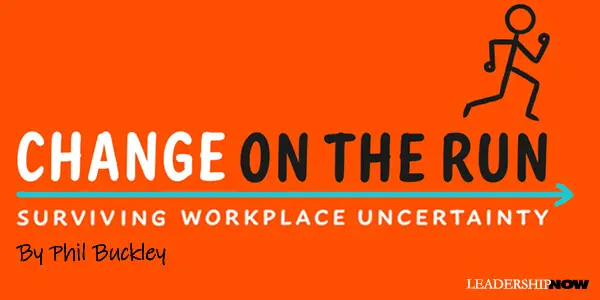
IF THE ADAGE “the only constant is change” described our pre-pandemic lives, “the only thing you can rely on is uncertainty” expresses our current realities. Changes have never been at a higher rate or faster pace than they are right now. Most people grapple with multiple disruptions, from hybrid teams to restructuring, digital transformations, and mergers and acquisitions. Uncertainty is now a workplace norm, and quickly managing new circumstances is a must-have survival and success capability. Why Uncertainty is Difficult The biggest challenge most leaders and managers face is deciding what to do when confronted with a new situation. Their career experience doesn’t provide the context needed to quickly take the best action that will move them forward. A marketing manager, for example, can easily create a brand positioning statement for a new brand—they have the knowledge, skill, and experience to draw upon. However, this doesn’t apply to change initiatives where the type of change, the context for it, and the project team are new. Their functional experience provides little guidance, especially when objectives and stakeholders span across their organization. Managing Uncertainty Many leaders take multiple actions when faced with uncertainty, hoping that something will address the situation. Often, trying everything achieves nothing because their efforts are uncoordinated and conflicting with insufficient resources to execute well. This approach often gives leaders poor results and a reputation for not being at their best. The best strategy for managing uncertainty is to focus your efforts on one action that will give you the best results. Typically, it will give you 80 percent of the results in 20 percent of the time and free you up to move on to the next task or issue. You need to excel in three areas of capability when managing uncertainty: managing me, managing the work, and managing others. Managing Me is the ability to be your best while accommodating a fast-moving change agenda; Managing the Work is about understanding the steps and activities to progress through a transition; and Managing Others is about aligning people on goals and enabling them to work collaboratively to achieve them. Each one contains situations you or your stakeholders may face or tasks you need to address to succeed. Let’s take a look at an example from each area to see how focusing on one action can give you 80 percent of the results in 20 percent of the time. Managing Me: Managing the Unknown Unknown situations are challenging because we can’t rely on our experience to guide our thoughts, actions, or behaviors; we don’t know what to do. To manage the unknown, take stock of what you know and don’t know. Creating lists for each will form a clearer picture that often looks like something you’ve seen in the past. The three steps to do so are:
Evaluating what you know and don’t know will transform the information you have into something more than the sum of its parts, moving you into more familiar territory. Managing the Work: Communication Effectively Good communication is the most important form of support people receive when going through times of uncertainty. It’s also the biggest enabler of successful change because it aligns everyone on their understanding of what’s changing, why it’s necessary, how it will affect them and what they must do to adopt it. Focusing on always being the best source of information ensures that people are guided by your messages and can ignore informal ones that are misaligned or incorrect. The three steps to do so are:
People seek out the most credible information they can find. Providing timely, complete, honest, and relevant updates ensures they will seek out, listen to, and be guided by you. Managing Others: Earning Trust Trust is the antidote to fear of uncertainty. Without it, people spend their energy protecting themselves from harm. When meeting someone new or learning about an unclear change, people’s “fight, flight or freeze” response is often triggered, causing them to either defend their territory or hide. Both responses add risk and slow you down. When people have trust, they collaborate toward a common goal even when it is not fully defined. People rarely trust those who don’t trust them. Demonstrating your faith in them by asking for their help inspires the same response toward you. The three steps to trusting first are:
Being indebted to someone provides an opportunity to support them, which creates a bond of trustworthiness. When people trust each other, they form a partnership that combines abilities and resources to address uncertainty. Managing uncertainty is a reality we all face in our current workplaces. We are moving into new territory with experience to draw upon. The best strategy is to focus our efforts on the actions that will give us the best results, the ones that will give us 80 percent of the benefits in 20 percent of the time. You will accomplish more, have more time for other tasks, build your change capabilities and your confidence, too.  
Posted by Michael McKinney at 07:19 AM
07.22.21

Leading Thoughts for July 22, 2021
IDEAS shared have the power to expand perspectives, change thinking, and move lives. Here are two ideas for the curious mind to engage with: Former CEO of Honeywell International, Larry Bossidy, on the behaviors a leader should look for in his or her direct reports: “Over the years, I’ve observed that certain behaviors, on the part of both the subordinate and the boss, are conducive to productive and rewarding relationships. Indeed, I’ll favor someone who exhibits the behaviors I expect over someone who doesn’t, even if the latter’s numbers are slightly better because I know the former has the potential to contribute more to the organization over time.” Source: Harvard Business Review, “What Your Leader Expects of You” Marc and Samantha Hurwitz on the importance of followership on management performance as you move up the organizational ladder: “There is a lot less forgiveness for poor followership at the middle-manager level because much more of the job is about building partnerships, setting an example, and working in the larger organizational context. Being technically strong is no longer enough to shine. At senior management levels, followership becomes the primary consideration. In our experience, senior executives have the highest levels of followership skill and the greatest conceptual understanding of it, and are most likely to acknowledge followership behaviors.” Source: Leadership is Half the Story: A Fresh Look at Followership, Leadership, and Collaboration Look for these ideas every Thursday on the Leading Blog. Find more ideas on the LeadingThoughts index.
Posted by Michael McKinney at 12:38 AM
07.19.21

Choosing Courage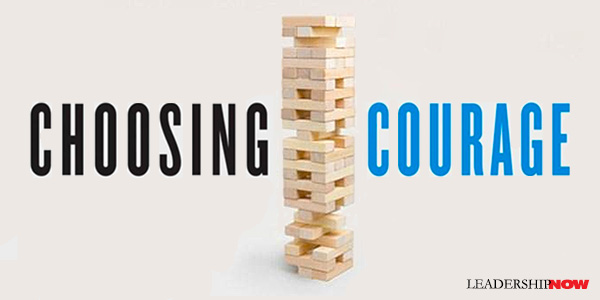
WITHOUT A DOUBT, courage matters—and we need more of it. Courage to see the right thing done. Courage to present a new idea. Courage to innovate and grow. Courageous acts can be risky—career-wise, socially, and sometimes physically. But if it weren’t risky, it wouldn’t be courageous. Acts of courage are worth considering to not only help others and yourself but to avoid regret. Acting courageously can help to solve problems, avert disasters and open the doors for opportunities. It also means taking personal responsibility even when it hurts. Author and consultant John Izzo wrote, “We must live with courage, moving toward what we want rather than away from what we fear.” In Choosing Courage: The Everyday Guide to Being Brave at Work, Jim Detert says we can all learn to be more courageous. But to do it right requires preparation and the right mindset. Courageous people sometimes pay a price for being courageous, “but often it’s not nearly as bad as we, or they, anticipate. And they seldom regret what they did, because they know I was the right thing to do based on their values, whether they’re defending someone else, doing what’s best for the organization, or simply being able to sleep well at night.” Detert defines workplace courage as “taking action at work because it feels right and important to stand for a principle, a cause, or a group of others, despite the potential for serious career, social, psychological, and even physical repercussions for doing so. That definition could give one the impression that we should act courageously whenever we get the urge. Ranting is not a courageous act. Acting courageously requires good judgment, as well, as Detert makes clear. One of the most important points he makes in the book is that the outcome of your courageous move hinges a great deal on how you behave—how you present it—and your reputation. We can confront, challenge, or disagree with powerful people in ways that evoke more or less threat, anger, and defensiveness simply by changing the how, where, or when of what we say or do. Of course, this is true no matter to whom you are speaking. Reading the situation and proceeding with humility is critical. Sometimes too, what we perceive is not reality. Detert presents five steps to increase the likelihood of a positive outcome and decrease the odds of negative personal consequences when acting with courage in any context.
Creating the Right Conditions Build your reputation before there is a need to be courageous. “This means creating a strong internal reputation which involves being seen as humble, kind, and generous, and also as a consistent high performer.” If you are seen as someone who has the organization’s and other people’s interests at heart, your words will be seen as less threatening, and you are more likely to get an audience. “If you haven’t routinely demonstrated emotional ability and stability, people aren’t likely to respond well to your courageous act.” With a track record of emotional maturity, you will buy yourself a lot of goodwill. Furthermore, don’t take sides. “When you’re seeking support from others, you’ll fare better if the people involved feel you’re acting on behalf of a collective interest that includes them.” Choosing Your Battles Not all battles are worth fighting. “Work life is filled with things that irritate or anger us, frustrate or disappoint us, and fill us with passion about what our organization could be doing more of or doing better.” You need to be very clear about what is really important. If you take issue with everything (most things), you will be labeled as a troublemaker, and your influence will be compromised. Good questions to ask are: What are my key values and goals?
And get the timing right. Competently courageous people pay attention to timing. They recognize that even the most reasonable comment or idea, presented in the most constructive way possible, may still fall flat or lead to trouble if delivered at the wrong time.Managing the Message We run into trouble when we make the message about us. “Understanding how others see the issue, what they care about, and what kinds of data and solutions they are most likely to find compelling allows us to make many important decisions about how to present our message and connect it to others’ priorities.” The same message can be framed in ways that are less likely to offend and more likely to resonate with the target(s). People are more likely to accept your message when they believe you want to build on their prior efforts, include them in the future, and help them achieve their current priorities. Importantly, Detert also adds, “People don’t like to feel ambushed or ganged up on. So, if you have a chance to speak to someone in private—at least for the first time—you’re likely to get a better reception.” Channeling Emotions Success in presenting an idea or issue may very likely depend on how well you manage your emotions and those of the target of your courageous act. “Shaking while talking, going silent, or literally fleeing the situation because we’re scared at the first sign of resistance doesn’t help. While being angry might fuel action, failure to control it can undermine success. Managing our emotions makes it easier to focus on others’ responses.” Anger doesn’t help make your point. You should also be clear that you are merely offering a perspective—not the only perspective or relevant facts. Avoid common phrase like “the explanation…,” or “the obvious problem …,” or “it’s totally clear that ….” When we speak this way, we’re not just implying that there is only one point of view; we’re implying the valid view is the one we hold, and others who don’t see it that way are stupid or self-interested. This is what psychologists call naïve realism because it’s not an accurate view of the world. Finally, Detert writes, “The goal is to have your emotions be the motivation for action, but not the driver of how you behave.” After the Act Whether your courageous act went well or poorly, it is critical to follow up “whether to clarify a position or solidify next steps, check in and address lingering doubts, or thank those who have helped and share any credit for any wins.” No matter how skillfully you frame the change you’re suggesting or making, there’s a reasonable likelihood someone will be hurt, angry, or confused. After all, change implicitly says that something currently happening is a problem. You can’t ignore others’ feelings, hoping they’ll just get over them, but letting this negative energy fester can be bad for the changes you want. And it’s almost certainly a bad idea to ignore others’ feelings if you care about those relationships. In short, it’s usually worth it to address what you sense or know are lingering negative feelings, even if doing so feels like yet another courageous act. Detert packs a lot of wisdom into this book to help us do the fearful and difficult things in a way that gives us the best chance for a positive outcome. Much of his advice requires us to slow down and think about what we are trying to accomplish and the best way to approach the people we are trying to influence. Choosing Courage will help us to achieve greater impact without regret. 
Posted by Michael McKinney at 12:16 AM
07.16.21

Make It, Don't Fake It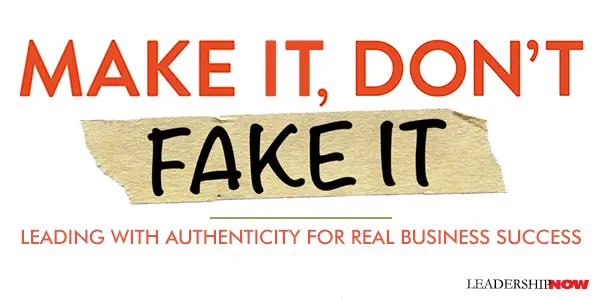
FAKE IT ‘TIL YOU MAKE IT is a common refrain in our culture. But it has been wrongfully used to justify all kinds of poor behavior and outright lies, as Sabrina Horn correctly points out in Make It, Don’t Fake It. Of all the business and career memes to gain popularity, few have compromised integrity in business, leadership, and personal success more than the expression “Fake it till you make it.” With roots in well-intentioned early twentieth-century psychotherapy, this phase has degenerated into a mantra that has encouraged and even normalized lying for the purpose of getting ahead. Now a product of modern American culture that rolls all too easily off the tongue, its mere existence tells you it’s okay to lie, from twisting the truth just a little to flagrantly deceiving others for personal gain. How true. We can’t be surprised by this in a culture that encourages selective truth, self-promotion, and short-cuts. While some use this maxim to fake a persona or misrepresent who they really are, it was never intended to be about lying. It is about becoming. It is a means to become something, not a state of being. In the same way, some people embrace vulnerability to ignore their weaknesses. The vulnerability culture that has sprung up is often used to help us justify our weaknesses rather than facing the truth and doing something to grow them to a non-toxic level. If, in our self-awareness, we realize that our authentic self is getting in our way and undermining our leadership, it’s time we did something about it rather than closing our eyes and slapping an authenticity label on it. Fake It ‘til You Make It is about acting “as if.” If you want more friends, it’s not about going around talking about all of the friends you have, but beginning to act in a way that invites friendships—like being friendly and smiling. Fake It ‘til You Make It is about taking on a mindset to produce results, not playing footloose with the facts, and lying about things that aren’t as though they were. To counteract this cultural condition, Make It, Don’t Fake It is about “ethics, passion, confidence, pride, resilience, commitment, and survival in a business context. It is about doing the right things the right way. This almost always means doing them the hard way.” Varying degrees of faking it falls along a continuum from acting “as if” to outright fraud. Horn discusses these various degrees of fakery—or call it what it is—deceit. In the heat of the moment, most of these fabrications are easy to fall into. It gets us by. But they take a toll not only on our character but also the enduring success that could be ours.
Horn then takes us through her journey as the CEO of a public relations and marketing communications agency. So, she knows what is fake and what isn’t and the consequences of each. We often think of PR and spin as one and the same, but done right says Horn, it isn’t. I like her perspective on it: There is a big difference in intent between misleading people by making something look better than it really is and simply bringing life to what is most compelling about it for the purpose of earning attention, interest, and trust. In our drive to succeed, the temptation is always there to cut corners and misrepresent ourselves. Horn begins with her first pitch to her first prospective client. I walked into PeopleSoft’s main conference room armed with a pack of business cards emblazoned with the initial name of my future company, Sabrina Horn Public Relations, and a logo the resembled a towel monogram. I had no employees, no clients, and except for the business cards, no evidence of a company, really. For anyone that has started their own company, this is an easily relatable scenario. What do you do? Misrepresenting the truth comes to mind. Faking it. Honestly, there were moments I was anxious enough to say to myself, Who am I kidding? This is nuts. They won’t take me seriously, so I had better make something up to sell them on me. But she didn’t. She disarmed her fear with preparation. When you are first starting out, doing and being anything to win the business is tempting—and also dangerous. You have to be bullish and yet stay grounded in the reality of what your company can realistically do, and then target those customers that want what you have to offer, with relatively few modifications. Horn covers what it means to start a business, the emotional ups and downs, the temptations, the risk, controlling growth, and the importance of establishing your values from the beginning. Throughout my career, whenever I was facing a crisis or felt rudderless, I attacked fear, uncertainty, and doubt and any stirrings of the imposter syndrome by referring to factual reality. I sought information to develop new strategies and options. There is a way to do it right. At the core of everything you do is integrity. And that includes creating and staying an authentic brand. The brand is the responsibility of the company’s founders and represents the why or the reason for being. Horn devotes an excellent chapter to your brand and culture and the issues involved in protecting and evolving it in a changing marketplace. She says leadership consists of two parts: winning and losing. While we like to focus on the wins, we will lose more often than we would like. No one is immune. And “it is really hard to act like a leader when you feel like a loser.” Horn shares a significant failure and the necessary after-failure postmortem. The value of a postmortem “is that it makes you face reality and keeps you from laying the blame elsewhere. The truth is, while relationships and stunts do matter, intelligence, insights, creativity, passion, and sheer effort can matter more. You lost, not because of what they did but because of what you didn’t do. There are situations where there’s just no winning. You can’t fake your age or your size or manufacture relationships you don’t have. Stay grounded, align around your core values and mission, and remind your team what you stand for. There is a reason why you and your people work at your company, and why other people don’t. Losing in these situations can be a blessing in disguise. And then there’s winning. When you are on a winning streak, know that things can and will change. Begin to plan for what is next. And a crisis will inevitably come out of nowhere. Plan for it, too, before it happens. Make It, Don’t Fake It is an excellent look at starting and leading a company from beginning to end with an integrity-at-all-costs perspective—how to make it without faking it. 
Posted by Michael McKinney at 12:30 PM
07.15.21

Leading Thoughts for July 15, 2021
IDEAS shared have the power to expand perspectives, change thinking, and move lives. Here are two ideas for the curious mind to engage with: Journalist George Leonard on mastery: “How long will it take me to master Aikido?” a prospective student asks. ‘How long do you expect to live?’ is the only respectable response. Source: Mastery: The Keys to Success and Long-Term Fulfillment General Gordon Sullivan and Michael Harper on what to do in uncharted territory: “The old maps, the old ways of doing business, will not work in today’s new territories. Simply improving an existing process will not solve a problem. This is the failure of the ‘R-words’—reshaping, reengineering, reinventing, and reposturing. Doing the same thing you have always done—no matter how much you improve it—will get you only what you had before. The old ways lead to the same old failures.” Source: Hope Is Not a Method: What Business Leaders Can Learn from America's Army Look for these ideas every Thursday on the Leading Blog. Find more ideas on the LeadingThoughts index.
Posted by Michael McKinney at 08:06 AM
07.12.21

How the Best in the World Reverse Engineer Success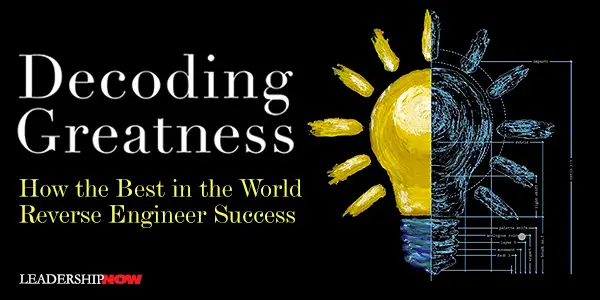
REVERSE ENGINEERING is systematically taking things apart to discover how and why they work. It is routinely done in tech—Steve Jobs and Bill Gates copied and improved on Xerox Palo Alto Research Center’s Alto computer to bring us the Macintosh and windows—but it is also done in with the best speeches, art, movies, music, and literature to discover what makes them so successful. Just as both “Jobs and Gates reaped enormous benefit from studying the works of their contemporaries, extracting crucial insights, and applying those lessons to develop new products, says Ron Friedman in Decoding Greatness, you can too. To reverse engineer is to look beyond what is evident on the surface and find a hidden structure—one that reveals both how an object was designed and, more important, how it can be re-created. One method employed by elite performers like Judd Apatow, Steven King, F. Scott Fitzgerald, Jack London is copywork. “It involves studying an exceptional piece of writing, setting it aside, and then re-creating it word for word from memory, later comparing your version to the original. Many of the painters we now celebrate as creative geniuses devoted a significant portion of their careers to copywork. Claude Monet, Pablo Picasso, Mary Cassatt, Paul Gauguin, and Paul Cézanne all developed their skills by copying the works of the French painter Eugène Delacroix. Delacroix himself spent years copying the Renaissance artists he grew up admiring. Why do it? Reproducing a piece demands that he or she pay careful attention to the organizational decisions and stylistic tendencies reflected in an original work. It is an exercise that enables novices to relive the creative journey and invite them to compare their instinctive inclinations against the choices of a master. Friedman adds that “copying challenges our default approach” and “it opens us up to novel ways of thinking, prompting us to find creative opportunities buried within our own work.” From science-based insights and the lives of a wide range of elite performers, Friedman has gathered ten lessons we can apply to our work. His findings are interesting and sometimes counterintuitive. Here are the ten lessons with key takeaways: #1 Become A Collector The first step to achieving mastery is recognizing mastery in others. #2 Spot the Difference To learn from your favorite examples, you need to pinpoint what makes them unique. What’s different? By comparing the stellar to the average, you can pinpoint key ingredients that give a work its flavor and identify particular elements that can be incorporated or evolved elsewhere. #3 Think in Blueprints Nearly every example you admire was developed using a blueprint. By working backward and crafting a blueprint, you will find patterns that demystify complex works. #4 Don’t Mimic, Evolve Copying someone else’s wildly successful formula wholesale is the fastest route to being perceived as unoriginal while contributing to a genre’s demise. #5 Embrace the Vision-Ability Gap Studying the masters comes with a price: it raises the bar on the performance you deem necessary to be successful. Don’t give up. Instead, celebrate the fact that we can sense when improvements are needed. That instinct is indispensable to achieving greatness. #6 Keep Score Selectively The first step to improving at anything begins with relentlessly keeping score. #7 Take the Risk Out of Risk-Taking Find stretch opportunities that don’t impose a high cost to failure. #8 Distrust Comfort We don’t grow when we are enjoying ourselves—we learn best when we are challenged, struggling, and occasionally failing. #9 Harness the Future and the Past Repetition and feedback can help you elevate your performance, especially when used to target your weaknesses. But if that’s the only practice you’re getting, chances are you’re only operating at a fraction of your potential. #10 Ask Wisely Experts rarely make great instructors. Studies show that the better we perform a task, the worse we are at communicating how we managed to do it. Knowing something makes it impossible to imagine not knowing it. What is interesting, too, is that we might think that the totally novel product or approach would win over your audience. But the most successful people develop successful formulas that “leverage (rather than violate) an audience’s expectations.” In a majority of cases, copying or over-relying on established recipes is a losing strategy that rarely results in memorable outcomes. Just as dangerous, however, is ignoring proven formulas altogether and overwhelming audiences with a flood of originality. People don’t crave novelty as much as we would think. Organizations routinely reject very creative ideas. “outright mimicry leads us nowhere. Absolute novelty is met with scorn.” Avoid both extremes. It’s better to use a proven formula and adding your own unique twist. 
Posted by Michael McKinney at 03:10 PM
07.09.21

The Imagination Machine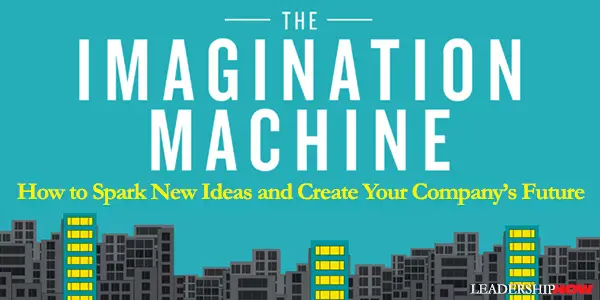
IMAGINATION is unique to humans and is key to creativity and innovation. In a time when elementary students today will be working in jobs that haven’t yet been created, imagination is the path forward. Imagination is the ability to picture that which doesn’t exist. In The Imagination Machine, authors Martin Reeves and Jack Fuller say that “For the sake of restoring the vitality of our companies, and for the societies these companies serve, we must better harness imagination.” “We spend much of our time in the realm of what is,” imagination is about what isn’t. Distinct from creativity and innovation, imagination extends beyond programs of innovation: “imagination is not just for inventing new products and services, but for fundamentally rethinking the mental model on which a company is based, even rethinking an entire industry or envisaging new industries.” The kind of imagination they are talking about is grounded in reality. “Imagination is not just random thoughts unhinged from reality. Rather, it rests on a causal understanding of reality. To the extent we understand the dynamics of the world—why things are the way they are—we can play with recombining and changing things in ways that still make sense and are feasible.” To get the ball rolling so we can begin nurturing and drawing from the imagination that exists inside all of us, they have presented a six-step process for creating ideas and bringing them to life. Step 1: The Seduction Imagination begins with a surprise. Surprise triggers imagination. It takes us “out of our routine way of looking at things into the realm of counterfactual thinking.” To increase the frequency of a productive surprise, the authors suggest we make the time for reflection, pay attention to our frustrations, seek the unfamiliar, reflect on unintended consequences and anomalies, draw analogies, and learn new ways of interpreting the world as it is. They say, “busy is the new stupid. It is precisely during the busy times that we should not forget to stare out the window.” Step 2: The Idea
Step 3: The Collision We need to act. Create a feedback loop from the mind to the world and back again. “A new mental model remains just an individual indulgence unless we act—to collide the idea with reality, spur our imagination again, and drive the evolution of the idea.” At this stage, we are looking for “a basic response from the world: Did the idea work—did the seed grow—or not?” At the same time, we want to look for surprise to evolve our idea. “In this mindset, instead of looking for a binary response from the world—did the idea work or not?—we are looking for the world to disrupt the way we think.” Step 4: The Epidemic Like a virus, an idea needs to spread from one person to many. One benefit of sharing it with others is we “accelerate its evolution by driving collective reimagination.” The key here is to be able to communicate the idea well so that everyone imagines the same thing. Step 5: The New Ordinary How do you execute and deliver the new idea? How do you make it the new ordinary? We do this by creating a clear script to guide others in a way that drives thought and action. The script should also be designed “so that it can evolve, to change in response to changing demands or opportunities.” Step 6: The Encore Amazon has been successful because they combine efficiency and imagination. Some companies invent something and live off that for decades leading to stasis and eventual decline. “To avoid this fate, your business must combine harvesting well-cultivated areas with exploring counterfactual landscapes.” The challenge is to do both. The core problem is that the imagining and executing mindsets don’t naturally fit together—in fact, they are often antagonistic. Emphasizing one has the potential to undermine the other. Tips for sustaining imagination in your organization include creating novel information flows and designing spaces for reflection while encouraging low-input time to explore the counterfactual.
The Imagination Machine is an exceptionally well-laid-out book. Each chapter begins with an outline, proceeds with the main point with an abundance of examples, a practical how-to section, and what keeps that from happening before finishing with games to play to build on and develop the qualities that spark ideas and imagination. For those who like visual reinforcement, they generously highlight their text with memorable graphics. 
Posted by Michael McKinney at 07:38 AM
07.08.21

Leading Thoughts for July 8, 2021
IDEAS shared have the power to expand perspectives, change thinking, and move lives. Here are two ideas for the curious mind to engage with: Louis L’Amour on pausing to take stock of yourself and ask: Where am I going? What am I becoming? What do I wish to do and become? “Up to a point a man’s life is shaped by environment, heredity, and movements and changes in the world about him; then there comes a time when it lies within his grasp to shape the clay of his life into the sort of thing he wishes to be. Only the weak blame parents, their race, their times, lack of good fortune, or the quirks of fate. Everyone has it within his power to say, this I am today, that I shall be tomorrow. The wish, however, must be implemented by deeds.” Source: The Walking Drum Peter Drucker on personal responsibility: “It is the mark of a mature person to ask: ‘What do I want to get out of life?’—and to know that one gets out only as much as one puts in. Tomorrow it will be the mark of a free person to ask: ‘What do I want to get out of organizations?’—and to know that one gets only as much as one puts in.” Source: The Age of Discontinuity: Guidelines to Our Changing Society Look for these ideas every Thursday on the Leading Blog. Find more ideas on the LeadingThoughts index.
Posted by Michael McKinney at 07:45 AM
07.06.21

Three Skills Managers Need in a Post-Pandemic World
COVID undoubtedly disrupted our worlds, especially the way we work. During the pandemic, not only did the concept of “office” shift dramatically but so did the needs and preferences of workers. Caught in the middle of all this were managers, the face of the organization to their teams. Over the past 15 months, managers spent a considerable amount of effort mediating and negotiating on behalf of their teams to their business and from their business to their teams. Throughout the process, many managers expressed how unprepared they felt leading their teams virtually and taking care of their team’s whole-life needs, as well as being compassionate while reinforcing the need to focus on delivering business results. As we continue to anticipate and prepare for a post-pandemic world, it’s safe to say that the working world, as we knew it, won’t return. It’s time to prepare for the skills managers need to develop in order to support both their teams and their business. Here are the three skills managers need to focus on and develop right now: #1. Virtual Presentation Skills. Even though Zoom fatigue is still real, virtual meetings aren’t going away. Virtual platforms will be a part of our workplace experience for the foreseeable future. Not only do managers need to grow more comfortable leveraging the technology, but they also need to learn how to present themselves and engage others while using it. Pre-COVID, when a manager wasn’t skilled in running a meeting or delivering a presentation, they were given grace. Some of them could even overcome their lack of skill with humor. Now, in the virtual room, if a manager’s presentation skills aren’t where they need to be, it’s no laughing matter. The manager runs the risk of low engagement and loses assurance that the message they’re sending is being received. Managers need to own responsibility for:
#2. Advocating. If COVID taught us anything, it’s that our team members are unique and have very personal, very real challenges related to being able to perform to their fullest potential at work. They also have goals for themselves, personally and professionally. Many desire to make changes in their lives to maintain the positive aspects and benefits of working during COVID, such as increased family time, more time to focus on their wellness, and the savings gained from not commuting to work. Managers realize that being flexible throughout COVID was their key to retention. In order to ensure retention and engagement, they need a framework to understand how to advocate and negotiate on behalf of their teammates, as well as an understanding of how to discern which employee requests should be taken into consideration and which ones should be renegotiated to better accommodate the business’s needs. As managers are often the go-to person for both the business and the employee, they can get caught between conflicting priorities. A skilled manager knows how to handle these issues with deftness, as well as how to bring creativity into the scenario in an attempt to create win-wins. #3. Leading in a Virtual World. As many businesses are embracing workplace flexibility, it’s certain that a hybrid working world will be the reality most workers encounter for the rest of their careers. Managing and leading in-person is easier when you’re available for pop-ins, can oversee directly work product, and can give real-time feedback. Leading in a virtual world requires intentional interaction. Team members and their managers must force time to engage and collaborate, and both need to be willing to keep coordinated time on their calendar for such engagement. It’s on the manager to make sure their rhythm allows for multiple types of conversations:
Managers need to be structured, proactive, and disciplined to have this necessary – and high level of engagement. These three skills have long been valuable for managers; in a post-COVID world, their interpretation and implementation have taken on a new twist. Yet, these skills are possible for any manager, at any level, to embrace, develop, and express. 
Posted by Michael McKinney at 08:07 AM
07.04.21

10 Books You Should Read This Summer
LIKE HIS MOTHER Rose, John Kennedy believed that reading constituted the most important instrument of knowledge. JFK‘s advisor Ted Sorensen said he read widely on history, biography, and politics. “But he had little interest in abstract theories. He primarily sought truths upon which he could act and ideas he could use in his office.” Reading gives us a chance to reflect on our lives, grow our knowledge, and become more creative. Never threatened by opposing views, Kennedy welcomed new and even controversial perspectives. He stated in the Saturday Review magazine in October 1960: If this nation is to be wise as well as strong, if we are to achieve our destiny, then we need more new ideas for more wise men reading more good books in more public libraries. These libraries should be open to all—except the censor. We must know all the facts and hear all the alternatives and listen to all the criticisms. Let us welcome controversial books and controversial authors. For the Bill of Rights is the guardian of our security as well as our liberty. With a few extra hours of daylight, the summer is an ideal time to relax and read. Listed below are ten books released this year that will entertain, make you think, and improve your leadership. Pick at least three and take some time to make yourself better this summer.*
To think again may make us uncomfortable. But rethinking can also help us find solutions to old problems, deepen our perspective, release us from inherited dogma and other people’s opinions, and understand how our closely held values relate and are applied to our changing environment. As JFK advised in the statement above, our challenge is to listen to others and to rethink those deeply held ideas and beliefs that tend to divide us—especially those ideas that we have blindly accepted from others.
This book discusses seven tests that all leaders face in one form or another. Their goal in writing the book is “to start conversations, not end them, and to provide guidance and frameworks to help refine your thinking and strategies on the aspects of leadership that matter most.”
Wherever there is judgment, there is noise. Noise is a hidden force that clouds our judgment and undermines our decisions. It is variability in judgments that should be identical. We can make better choices by reducing both noise and bias by following the prescriptions offered here.
Change comes most readily when you turn an uphill battle into a downhill one. You will learn methods for identifying and overcoming common barriers to change, such as impulsivity, procrastination, and forgetfulness. This book will help you reshape your environment and improve your trajectory by utilizing fresh starts and cues, building flexible habits, and more.
We are told to work smarter, not harder. Friedman will show you how. By reverse engineering what has worked for others, we can unlock patterns that will work in our own lives. How do you take apart a work you admire, enabling you to extract its formula and unleash your own creative juices?
Baldoni reflects on the practical application of grace. Over the course of the last year, he has collected his thoughts on the response to the pandemic and its implications. These notes touch on many elements of what it means to be a good citizen, a friend, and a leader. A quick read but plenty to meditate on.
Instead of looking for balance, learn to be where your feet are. Finding balance is “like aspiring to be in the middle.” On the other hand, “being present, focused, committed, and hardworking at home and at work is the path to finding success and fulfillment.”
Gladwell asks, “How is it that, sometimes, for any number of unexpected and random reasons, technology slips away from its intended path?” The Bomber Mafia held to their belief. “They persisted, even in the face of technology’s inevitable misdirection, even when abandoning their dream offered a quicker path to victory, even when Satan offered them all the world if only they would renounce their faith. Without persistence, principles are meaningless. Because one day your dream may come true. And if you cannot keep that dream alive in the interim, then who are you?”
When the conversation changes from a discussion of ideas to a battle between good and evil—you’re good they’re bad—then the game changes, and we feel increasingly certain of our own superiority and, at the same time, more and more mystified by the other side. It doesn’t have to be this way. You can rehumanize the other side, restore your curiosity, and break free from outrage.
The pressure is always to have more. So we keep adding more and more. We add tasks, commitments, and possessions while neglecting to subtract any. Ironically, the secret to having more is to subtract. Make a “To Don’t” list. The summer is an excellent time to ask yourself what you could take away to have more. *If you struggle to read or doubt the immense payoff for doing so, you might pick up Jeff Brown and Jesse Wisnewski’s Read to Lead: The Simple Habit That Expands Your Influence and Boosts Your Career (August 2021).
Posted by Michael McKinney at 12:04 AM
07.02.21

Three Secrets to Building Strong Leaders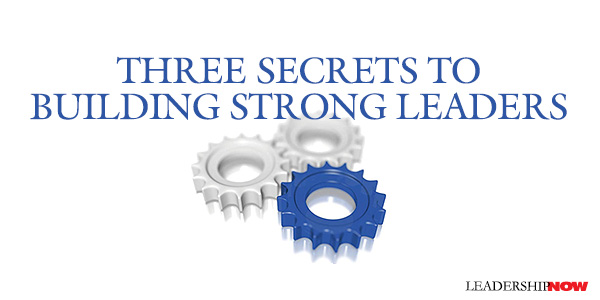
TOO many leaders are stuck in mediocrity. A Ketchum study found that only 23% of the 25,000 surveyed believe their leaders are leading well. Only 31% believe leaders communicate well. Only 17% have confidence that leadership will improve in the upcoming year. And after the 2020-21 Covid response, I doubt those statistics have changed much. Alain Hunkins, author of Cracking the Leadership Code, says “there is a path out of the muddle of mediocrity. Great leaders aren’t born—they’re made. If you are committed, you can learn and apply specific tools to improve how you lead.” Great leaders share these three fundamental qualities: connection, communication, and collaboration.
Connection The foundation of connection is empathy. Connection builds trust, insight, engagement, and results. So why don’t we see more of it? One reason is we simply don’t practice it. “It needs to be exercised regularly to get stronger. If you don’t use it, it atrophies.” Another reason is a rigid, right-wrong mindset. A right-wrong mindset can lead to controlling behavior. Needing to be right, disconnect you from others. “Clinging to a need to be right closes you off to the perspective and experience of others. You don’t listen—you fake listen.” A third reason is we fear empathy will open up an emotional can-of-worms. Not to mention the fear that expressing vulnerability will be taken advantage of. Fourth, we are too impatient to take the time to be empathetic. It’s true. Empathy takes time. “Leader with a bias for action may be operating with the unconscious belief that they don’t have time to offer empathy. But this belief has an unintended impact: Making those around them feel less valued and understood. When people feel devalued, their motivation plummets. These lead to declines in performance. Ultimately, results suffer.” There is also what is called the hot-cold empathy gap. That is, how our emotional state affects our ability to relate to someone else in an opposite emotional state. If I’m calm, it is difficult to relate to someone experiencing anger. And finally, the higher we go in an organization, the disconnected we become from those under us. Leading isn’t an abstract idea that exists between you and somebody else or a group of people. It’s a connection that’s built through a genuine relationship. Communication We would all agree that communication is critical to what we do, and we assume it is happening. We take it for granted. And we shouldn’t. There are three major obstacles to communication. The typical problem is that we are not on the same page. What I say is not what you hear. I know what I mean but do you. It’s called projection bias when we assume others know what we are thinking. Better to assume that what we mean is not what they understand and clarify. Those you are communicating with need context. You know why what you are saying is important and what needs to be done about it. When communicating, others need to know the background of your thinking. They need to know why you are saying what you are saying so they can act appropriately. Another common issue is overload. We are overwhelmed with information. “People have plenty of other messages competing for their precious brain cells. They’re not going to focus on you just because you want them to. People don’t want more information—they want insight.” Hunkins says to improve your communication you need to communicate with the end in mind, have a central message, create checks for understanding, own and fix communication breakdowns, make the implicit explicit, and master the medium—raise your communication game.” Collaboration To lead, you need the abilities and experience of everyone in the room. Collaboration takes your effectiveness to a whole new level. It is an increasingly important skill to have in our digital age. “Although you can’t motivate anyone else, you can design the conditions in which they motivate themselves. You can use your understanding of human needs and the employee experience to lead a team of joyful, engaged, and high-performing people.” Hunkins covers these topics well and also the need to simplify so that you don’t get in your team’s way. All three of these qualities are more challenging for the leader in this digital age. Organizations are increasingly made up of people who do not share common cultural backgrounds. These differences manifest themselves in the way people communicate and think. It becomes a challenge when building trust and collaboration. 
Posted by Michael McKinney at 10:05 AM
07.01.21

First Look: Leadership Books for July 2021Here's a look at some of the best leadership books to be released in July 2021. Don't miss out on other great new and future releases not listed here.
According to a Fortune 500 study, as much as 80% of working time is lost to tiresome meetings, unclear expectations, difficult decisions, and other wasteful delays. Overcoming the lack of clarity behind this waste - on both an individual and organizational basis - would reap huge rewards. In The Power of Clarity, Ann Latham exposes the unrecognized confusion and explains how to eliminate it. This fascinating guide to workplace productivity and effectiveness draws upon extensive research and case studies to demonstrate how you can get better results in far less time while also increasing confidence and commitment.
Trust is, however, an elusive, even mushy, concept. Creating and sustaining trust does not, Sandra Sucher and Shalene Gupta show, come from "reputation-building" and PR but by being the "real deal," creating products, services, and technologies that work, having good intentions, treating people fairly, and taking responsibility for all the impacts an organization creates, whether intended or not. Then, through a framing of how to think through the elements of trust - competence, motives, means, impact - combined with in-depth stories from twenty years of research we emerge with a new understanding of the business, economic and societal importance of trust and how to regain it once lost. How to, in short, bridge the gap from where you are to where you should be.
In Persuade: The 4-Step Process to Influence People and Decisions, accomplished sales, negotiation, and influence experts Andres Lares, Jeff Cochran, and Shaun Digan PhD deliver a concise and insightful take on how to transform your ability to persuade others regardless of the setting. Persuade is perfect for executives, managers, entrepreneurs, and other business leaders and will earn a place in the libraries of any professional who negotiates or influences on a regular basis. It is an invaluable resource for anyone seeking to improve their persuasion or deal-making abilities.
Meritocracy: the idea that people should be advanced according to their talents rather than their birth. While this initially seemed like a novel concept, by the end of the twentieth century it had become the world's ruling ideology. How did this happen, and why is meritocracy now under attack from both right and left? In The Aristocracy of Talent, esteemed journalist and historian Adrian Wooldridge looks outside western cultures and shows what transformative effects it has had everywhere it has been adopted, especially once women were brought into the meritocratic system. He also shows how meritocracy has now become corrupted and argues that the recent stalling of social mobility is the result of failure to complete the meritocratic revolution. Rather than abandoning meritocracy, he says, we should call for its renewal.
When it comes to raising children in a digital world, every parent feels underprepared and overwhelmed. We worry that our children will become addicted to online games, be victims of cyberbullying, or get lost down the rabbit hole of social media. We warn them about all the things they shouldn't do online, but we don't do nearly enough to teach them the skills of digital well-being. It's time to start a new conversation. In Digital for Good, EdTech expert Richard Culatta argues that technology can be a powerful tool for learning, solving humanity's toughest problems, and bringing us closer together. He offers a refreshingly positive framework for preparing kids to be successful in a digital world—one that encourages them to use technology proactively and productively—by outlining five qualities every young person should develop in order to become a thriving, contributing digital citizen.
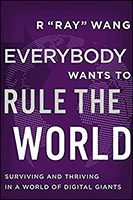 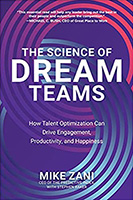 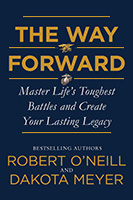
 Build your leadership library with these specials on over 28 titles. All titles are at least 40% off the list price and are available only in limited quantities. “Even when reading is impossible, the presence of books acquired produces such an ecstasy that the buying of more books than one can read is nothing less than the soul reaching towards infinity.” — A. Edward Newton
Posted by Michael McKinney at 02:40 PM

Leading Thoughts for July 1, 2021
IDEAS shared have the power to expand perspectives, change thinking, and move lives. Here are two ideas for the curious mind to engage with: Former Chairman and CEO of Pepsico, Indra Nooyi, on assuming positive intent: “My father was an absolutely wonderful human being. From him, I learned to always assume positive intent. Whatever anybody says or does, assume positive intent. You will be amazed at how your whole approach to a person or problem becomes very different. When you assume negative intent, you’re angry. If you take away that anger and assume positive intent, you will be amazed. Your emotional quotient goes up because you are no longer almost random in your response. You don’t get defensive. You don’t scream. You are trying to understand and listen because at your basic core you are saying, ‘Maybe they are saying something to me that I’m not hearing.’ So, assume positive intent has been a huge piece of advice for me.” Source: Fortune, “The Best Advice I Ever Got” Director, producer, and screenwriter Steven Spielberg on collaboration. In the interview he was asked, “What keeps you excited about making movies?”: “I get that same queasy, nervous, thrilling feeling every time I go to work. That’s never worn off since I was 12 years-old with my dad’s 8-millimeter movie camera. The thrill hasn’t changed at all. In fact, as I’ve gotten older, it’s actually increased, because now I appreciate the collaboration. Source: The New York Times, “The Adventures of Spielberg: An Interview” by Mekado Murphy, December 20, 2011 Look for these ideas every Thursday on the Leading Blog. Find more ideas on the LeadingThoughts index.
Posted by Michael McKinney at 12:08 AM
|
BUILD YOUR KNOWLEDGE


How to Do Your Start-Up Right STRAIGHT TALK FOR START-UPS 
Grow Your Leadership Skills NEW AND UPCOMING LEADERSHIP BOOKS 
Leadership Minute BITE-SIZE CONCEPTS YOU CAN CHEW ON 
Classic Leadership Books BOOKS TO READ BEFORE YOU LEAD |
|